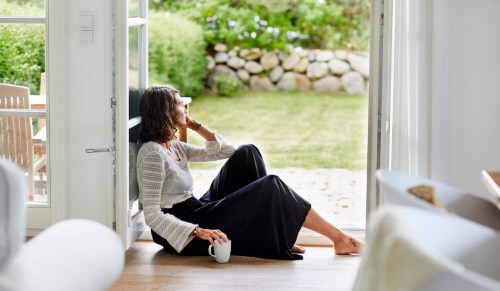Sometimes our bodies react quicker than our minds. Maybe you walk into a room and your chest instantly tightens; maybe your pulse quickens and your head pounds every time you watch a certain type of movie scene; maybe your shoulders feel heavy for weeks on end. Our bodies are physical manifestations of our experiences, which means they’re often processing or holding onto traumas that we didn’t even know were there. By definition, trauma is any deeply distressing or disturbing experience, and understanding how we hold trauma in our bodies can help us figure out how to release it effectively as part of a healing process.
Experts in This Article
certified Pilates instructor and co-founder of ALL Method Studio
Thoko Moyo is a registered clinical counselor in British Columbia who specializes in trauma and focuses on supporting Queer Trans Black Indigenous People of Colour (QTBIPOC).
“When we look at a traumatic experience that someone has, it is encoded in our brain and in our memories, and then that can also translate to living in our muscles and our heart,” says Thoko Moyo, a registered clinical counselor who specializes in trauma and focuses her practice on supporting Queer Trans Black Indigenous People of Colour (QTBIPOC). “It’s all connected. What a person is experiencing or what they’re coming to a session with me for is centered around. It can be different parts of the body.”
Seventy percent of U.S. adults experience at least one traumatic event estimates the National Council for Mental Wellbeing. And like our traumas themselves, how we hold trauma in our bodies is different for everyone. For Katie McKenzie, a certified Pilates instructor and founder of the A La Ligne movement method, abuse from her past was locked in her pelvic floor.
“It was my trauma response to sexual assaults,” she says. “And the overwhelming sensation I felt was that yes, my pelvic floor was locked, but also that so much of me was locked and loaded and prepared for battle.” It led her to create A La Ligne, which combines Pilates, qigong (an ancient mind-body meditation practice), and somatic experiencing (a form of therapy that centers around body trauma). “Once someone is empowered with the knowledge and the felt sense of what’s happening in their own unique and individual body, they can be empowered to move and shift the fear,” McKenzie says.
If you think your body is holding onto trauma, Moko says it’s a good idea to seek out a professional counselor who can work with you to unpack the layers of your experience. If counseling is not an accessible option for you, here are some simple ways to help your body through a trauma response.
Breathe
Moyo and McKenzie both list breathing techniques as central to the process. Moyo suggests box breathing (in which you breathe in for four seconds, hold for four seconds, breathe out for four seconds, then wait four seconds before inhaling again) and bumblebee breathing (in which you breathe in and then breathe out with a humming sound) as great options for calming and re-centering.
She also suggests a three, two, one method in which you name three things you see, three things you hear, and three things you feel, and then take a deep breath and repeat the process for two things and then one thing. “Breathing brings us back into our body,” Moyo explains. “It brings us back into the space and grounds us.”
Move
“Movement has such a powerful role in the ability to heal because it brings the mind, the breath, and the body together all at once,” says McKenzie. She stresses the importance of meeting your body where it’s at, and of not being ashamed or nervous if your muscles start to tremble (even during “easy” movements). “Shaking can be an indication of new neural pathwaysand new connections from the brain to the bodies that haven’t been accessed before,” she explains. “I just say, ‘It’s okay. This is a normal occurrence. This is your body reconnecting to itself. It’s a good thing.’”
Connect
“Isolation is one of the worst things that people can do, even though it’s oftentimes what people are drawn to or want to do,” says Moyo. “One of the biggest ways to combat body experiences of trauma is through connections and community.” So build up your support system, whatever that looks like for you. It could be group therapy; it could be close family or friends; it could be anetwork of people who share some of your lived experiences. The important part is that you seek out and nurture human connection to help you remember that you’re not alone.
Oh hi! You look like someone who loves free workouts, discounts for cutting-edge wellness brands, and exclusive Well+Good content. Sign up for Well+, our online community of wellness insiders, and unlock your rewards instantly.
Sign Up for Our Daily Newsletter
Get all the latest in wellness, trends, food, fitness, beauty, and more delivered right to your inbox.
Got it, you've been added to our email list.











